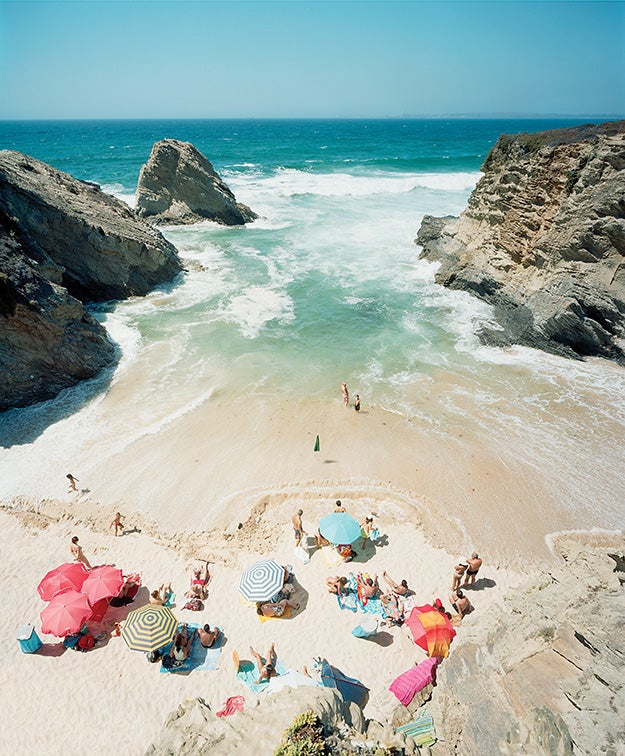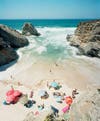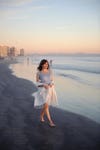Pro Tips For Shooting Better Photos at the Beach
Try them, and you’re sure to return from vacation with more than just a suntan






Catch a Wave Ah, the stuff of summer dreams—the sweet spot where sand meets sea, where children play and adults lounge, where oceanic wonders call out invitingly—the beach is a photographer’s paradise. And it can be a camera owner’s nightmare.
“You have to be careful with the salty sea spray that can condense on your camera and lens,” says Santa Fe-based shooter Michael Clark, who caught this cresting wave at Waimea Bay on Oahu, Hawaii. But Clark shot this at a safe distance from the spray, taking advantage of the shoreline’s angular curve. “The waves at Waimea break pretty far from the actual beach, but because of the way the cove bends you can get on axis with the waves and see into the barrels. Autofocus isn’t super-critical because the waves break in a relatively consistent place.” If you’re shooting waves as they come toward you on shore, though, you’ll need to use AF because of their speed and unpredictability.
Indeed, the challenge is the sea’s constant movement. “You need to shoot hundreds of images of every wave so that you can capture the split-second perfect moment,” Clark says. “Here, I shot more than 2,000 images in a couple of hours. This one was when the first rays of light were hitting the wave at sunrise, which gives it the wild array of colors.”
Like a surfer, anticipate where waves are going to break and position yourself to catch them. “Put your camera on a ball head to swivel and react quickly,” Clark advises. “The reality is waves happen so fast that if you aren’t already shooting by the time you see it, it’s over and gone.”
Get Up High Your vantage point can frame a composition—as evidenced by this shot by French photographer Christian Chaize, who perched his camera and tripod on a rock outcropping far above a secluded cove in southern Portugal. “Don’t fall down!” Chaize jokingly advises. “And try not to give the impression that you are photographing people—someone might get upset.”
In fact, Chaize relies on the distance from his subjects to record candid social studies. This image is part of a long-term series, Praia Piquinia, in which he uses this same vantage point to document changing tides, weather patterns, color variations, and human interactions. “With perseverance and a commitment to this place, I have been rewarded: There is always something new,” he says.
In deciding when to shoot, Chaize watches for drama—“a ball suspended in the air, a wave, an exchange between a couple”—but he notes that surprises often appear when he develops his film. “That can impart the image with a meaning that I didn’t anticipate, or couldn’t have made up if I’d tried.” In addition to a wide-angle scope, he uses the vertical format “to put my subject matter in the form of a portrait—an ongoing record of this corner of nature.”
Chaize’s bird’s-eye view also lends this photograph an effective array of high contrasts and crisp shadows, even in high-noon conditions. “My axis of shooting is northwest, which is a distinct advantage,” he says, “because at all hours, the light is beautiful.” He notes that the key is keeping the sunlight at an angle to the camera: “You need to be sure that the sun isn’t directly hitting the lens.”
Catch a Wave Ah, the stuff of summer dreams—the sweet spot where sand meets sea, where children play and adults lounge, where oceanic wonders call out invitingly—the beach is a photographer’s paradise. And it can be a camera owner’s nightmare.
“You have to be careful with the salty sea spray that can condense on your camera and lens,” says Santa Fe-based shooter Michael Clark, who caught this cresting wave at Waimea Bay on Oahu, Hawaii. But Clark shot this at a safe distance from the spray, taking advantage of the shoreline’s angular curve. “The waves at Waimea break pretty far from the actual beach, but because of the way the cove bends you can get on axis with the waves and see into the barrels. Autofocus isn’t super-critical because the waves break in a relatively consistent place.” If you’re shooting waves as they come toward you on shore, though, you’ll need to use AF because of their speed and unpredictability.
Indeed, the challenge is the sea’s constant movement. “You need to shoot hundreds of images of every wave so that you can capture the split-second perfect moment,” Clark says. “Here, I shot more than 2,000 images in a couple of hours. This one was when the first rays of light were hitting the wave at sunrise, which gives it the wild array of colors.”
Like a surfer, anticipate where waves are going to break and position yourself to catch them. “Put your camera on a ball head to swivel and react quickly,” Clark advises. “The reality is waves happen so fast that if you aren’t already shooting by the time you see it, it’s over and gone.”
Get Up High Your vantage point can frame a composition—as evidenced by this shot by French photographer Christian Chaize, who perched his camera and tripod on a rock outcropping far above a secluded cove in southern Portugal. “Don’t fall down!” Chaize jokingly advises. “And try not to give the impression that you are photographing people—someone might get upset.”
In fact, Chaize relies on the distance from his subjects to record candid social studies. This image is part of a long-term series, Praia Piquinia, in which he uses this same vantage point to document changing tides, weather patterns, color variations, and human interactions. “With perseverance and a commitment to this place, I have been rewarded: There is always something new,” he says.
In deciding when to shoot, Chaize watches for drama—“a ball suspended in the air, a wave, an exchange between a couple”—but he notes that surprises often appear when he develops his film. “That can impart the image with a meaning that I didn’t anticipate, or couldn’t have made up if I’d tried.” In addition to a wide-angle scope, he uses the vertical format “to put my subject matter in the form of a portrait—an ongoing record of this corner of nature.”
Chaize’s bird’s-eye view also lends this photograph an effective array of high contrasts and crisp shadows, even in high-noon conditions. “My axis of shooting is northwest, which is a distinct advantage,” he says, “because at all hours, the light is beautiful.” He notes that the key is keeping the sunlight at an angle to the camera: “You need to be sure that the sun isn’t directly hitting the lens.”
Find the Golden Light “The sun can be harsh on the beach,” says Andrew Levacy, a wedding and portrait photographer based in Coronado, California, who specializes in waterfront imagery. “It can be crowded and it may be windy. However, we call the hour before sunset the golden hour because the light gets softer and people start to leave. And the wind tends to die down. That’s the best time to take pictures.” A case in point is Levacy’s portrait (above) of a woman named Katie walking footloose on the sand at sunset. “Get people moving to make a portrait appear more natural,” Levacy says. “I had her walk toward me and look into that nice soft light.”
Levacy often brings off-camera flash (with umbrellas). “Let’s say you’re meeting an hour before sunset: The light is still fairly bright, so off-camera light can help to fill some shadows. And if you want to show the colors of the sunset, they’re going to create a silhouette, so off-camera light helps.”
From behind the camera, the light at dusk still provides “that nice pink-orange soft glow in the background,” Levacy says. “So you can naturally backlight your subjects, or maybe have the sun off to the side, and there won’t be shadows on their face but it has a pastel, soft-lit look.”
Home in with a Macro Lens “Allow yourself to be in love with the subject, open to discovering the many aspects of it, be they old or new,” says Massachusetts-based photographer Harold Feinstein, who created the macro seashell study above. “You’ve got to have a sense of awe.” Here Feinstein sought to convey “the obvious relationship of this shell to the greatest aspects of architecture,” he says. “So I got in as close as I possibly could. The relatively small aperture [f/11] allowed me the most depth of field in that range, and thus I was able to get as much detail as I did. I was drawn not only to the extraordinary natural shapes of the seashell but also to its range of colors, almost like a rainbow itself.”
While this image appears carefully framed, Feinstein suggests an intuitive approach. “I work quickly so that [compositional] decisions are spontaneous and often not considered beforehand,” he says. “And I shoot a lot of exposures, so I have choices when editing.” During an illustrious photo career spanning more than half a century, the beach has been an oft-recurring location for Feinstein. “There’s a lot more light available than in most places, which makes it easier to close down the lens—sometimes even to f/22— which provides you with the most depth of field,” he says. “It’s great for close observation of these remarkable structures, born of the creatures who inhabit them. The phrase ‘form follows function’ certainly applies.”
Savor the Sunrise In stark contrast to action shots on the beach, sunrise images call for quiet, unhurried TLC. “Take your time, slow down,” advises wilderness photographer Rodney Lough Jr., who photographed the above scene in Hawaii. “If you want the imagery and the lighting and everything to be perfect, you can’t be thinking of where you want to be next; you have to be thinking about where you are.”
Lough notes that at daybreak, “not many people are usually up, and the day is still quiet and calm”—which allows for a tripod setup and long exposures (6.8 sec here) that capture nuanced lighting. “Expose for the highlights, because if you lose that data you cannot get it back,” he says. To accurately render the intense natural hues, he often shoots both sunrises and sunsets without filters. But in the case of his image here, “there is a fair bit of exposure difference between the darker elements in the foreground and the colorful sky,” Lough says. “To compensate, I used a graduated two-stop neutral density filter to help balance the tones. I also carry a four-stop neutral density filter, but I mainly use that in shots with brighter sunlight.”
Lough calls this picture “Harmony,” partly because it was shot on a special morning. “My wife and I were celebrating our 24th wedding anniversary,” he recalls. “Yes, I let her sleep in.”

